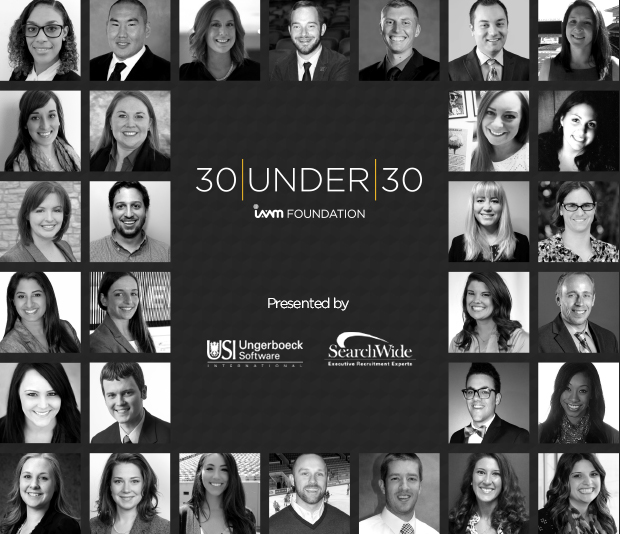30|UNDER|30 Spotlight: Abbie Vander Bol
We announced the recipients of the IAVM Foundation’s inaugural class of 30|UNDER|30 last week and told you we’d spotlight the recipients over the next few weeks.
Our first spotlight is on Abbie Vander Bol, the event supervisor for the Show Me Center on the campus of Southeast Missouri State University in Cape Girardeau, Missouri.
“Seeing people smile as they came in for an event and watching them talk about how much fun they had was why I fell in love,” Vander Bol said when asked about what made her fall in love with the industry. “It has been honor to be nominated for the first class of 30|UNDER|30.”
Please watch the video above to learn more about Vander Bol and her passion for the industry. Thank you, also, to SearchWide and Ungerboeck Software International for their generous support of the IAVM Foundation’s 30|UNDER|30 program.
Females Use Smartphones More Than Males During Live Events
Ticketfly recently had Harris Poll conduct a survey to find out how U.S. adults are using their smartphones during live events. Here are the top findings, according to a release from Ticketfly.
—Thirty-one percent of 18-34 year olds are using their phones during half of an event or longer.
—Forty percent of female smartphone owners 18-34 that attend live events say they use their phones to take pictures at events, compared to only 24 percent of males their age.
—Females in the 18-34 age range are also more likely than their male counterparts to share their experiences via social media apps during the event (35 percent vs. 22 percent, respectively).
—Seventy percent of smartphone owners age 18-34 who attend live events are interested in using their phone as their ticket to enter an event.
—Two thirds (66 percent) of smartphone owners age 18-34 who attend live events are interested in using their phone to pay for food, beverages, and merchandise.
If you’ve attended a live event in the past year, these numbers shouldn’t surprise you. Fans are increasingly using their smartphones to connect with friends, the venue, and the artist or team. What’s interesting about this survey are the findings around female use, specifically single females, during live events.
“Females—especially female millennials—are using their mobile devices during live events to capture their experiences and share with friends via social media,” wrote Chris Pappas, PR manager for Ticketfly. “Singletons are also more likely to share their live-event experiences via social media apps than their married counterparts. If people aren’t using their phones to spread a bit of FOMO [fear of missing out] around, they’re using them to search for relevant info.”
Pair that with the knowledge that more than 60 percent of those surveyed are interested in getting mobile notifications about offers for merchandise, food and beverage, and VIP access during a live event, and you have a great marketing opportunity to act upon however you see fit.
Please visit Ticketfly for more stats from the survey.
(photo credit: ShutterRunner via photopin cc)
IAVM Members Nominated for Women of Influence Awards
Congratulations to the following IAVM members who were recently nominated for the 2015 Women of Influence Awards from Venues Today.
Millie Dixon
Principal
Theatre Projects Consultants
Vicki Hawarden, CMP
President & CEO
IAVM
Dr. Kim Mahoney (one of the authors of our upcoming textbook)
Assistant Professor of Sport Management
University of New Haven (Conn.) College of Business
Kerry Painter, CFE, CEM
Assistant General Manager
Cox Business Center, Tulsa, Oklahoma
Carol Pollock
Executive Director
VenuWorks/Hoyt Sherman Place, Des Moines, Iowa
Robyn Schon
Global Spectrum, General Manager
Berglund Center, Roanoke, Virginia
Leslee Stewart
General Manager
Paramount Theatre, Oakland, California
Karen Totaro, CFE (in-coming IAVM chair)
General Manager
Atlantic City Convention Center
The deadline to vote is Wednesday, May 27. Visit Venues Today for more information and to cast your vote
HOK and USL Launch Stadium Development Initiative
HOK has announced a multi-year partnership with the United Soccer League (USL). HOK will lead a stadium development, design, and standards initiative supporting the league’s strategic initiative to house all USL clubs in soccer-specific stadiums across North America by the end of the decade.
“The groundbreaking partnership with HOK provides the league and its clubs a tremendous partner with extensive stadium design and development experience at the highest level,” said USL President Jake Edwards in a statement. “A critical part of our strategic growth plan is to have all USL clubs as owners or primary tenants of soccer-specific stadiums by 2020. Not only will these new and upgraded stadiums add value to the league and each club ownership group, they will establish a permanent base for the clubs within their local communities. These venues will serve as cultural hubs and bring fans together in support of the clubs while offering state-of-the-art amenities and an unparalleled game-day experience.”
HOK is the league’s official stadium design partner and will apply its venue design expertise to guide soccer-specific stadium development for expansion clubs and the renovation of current USL stadiums to increase capacities and amenities. HOK will also consult to the league and its clubs on maximizing venue revenue, developing ancillary programming, and creating operational efficiencies.
“This partnership reflects the USL’s commitment to expanding the soccer community across the country and providing fans a high-quality event experience that captures the energy and excitement of the game,” said Brad Schrock, HOK’s director of Sports + Recreation + Entertainment, in a statement. “We are passionate about soccer and excited to be a partner to the USL as the league continues to grow. This initiative will provide the framework to ensure that venues are successful for the team, the players, the fans and their communities.”
HOK’s portfolio of work includes the recently opened Avaya Stadium for Major League Soccer’s San Jose Earthquakes; a newly designed multipurpose stadium in Atlanta, which will be home to a MLS expansion franchise and the National Football League’s Atlanta Falcons; the renovation of Sun Life Stadium for the NFL’s Miami Dolphins; the proposed St. Louis NFL Stadium on the North Riverfront area of downtown St. Louis, which is designed to accommodate FIFA and MLS matches; and the renovation of the AT&T Center for the National Basketball Association’s San Antonio Spurs.
To learn more about soccer’s increasing popularity in the U.S., please read our FM feature, “Major League Soccer’s Resurgence.”
(Image: Christy Radecic)
The IAVM Foundation is Proud to Announce the Inaugural 30|UNDER|30 Class of 2015
Thanks to the generous support of SearchWide and Ungerboeck Software International, 30 young professionals, 30 years of age and under, will receive full complimentary registration to VenueConnect in Baltimore, a travel stipend of $850, and a one-year complimentary Young Professional IAVM Membership.
“Identifying and developing future leaders is an important priority, and IAVM has stepped up to the plate in a big way with this initiative. Venue management is an exciting and challenging career path, and it is crucial we prepare this group for the complexities of leading this industry forward,” said Mark Gnatovic, senior vice president of SearchWide and a Foundation Trustee. “Having access to industry education and industry leaders will create significant learning opportunities for these individuals. I’m looking forward to meeting the 2015 IAVM 30|UNDER|30 inaugural class.”
In addition to over $2,000 in benefits, the 30|UNDER|30 recipients will be recognized at the Venue Industry Awards Luncheon at VenueConnect on Monday, August 3. They will also be provided year-round continued education for professional growth in the venue industry to help program participants become better, more productive employees through increased access and exposure to industry networking and thought leadership.
As part of the Build an Amazing Future campaign focused on students, young professionals, and mid-level venue management, the IAVM Foundation’s Board of Trustees are thrilled to see this program come to life.
“On behalf of the IAVM Foundation’s Board of Trustees and committed donors, we are honored to announce the inaugural 30|UNDER|30 class of 2015,” said Jason Rittenberry, CFE, president and CEO of IRG Sports + Entertainment and chair of the IAVM Foundation. “We are truly building amazing futures for some of the top rising stars in the industry!”
Over the next few weeks, we’ll individually spotlight this year’s recipients. For now, let’s meet the IAVM Foundation’s inaugural 30|UNDER|30 class of 2015:
| Natalie Barrow Director of Arts Education & Community Outreach Cobb Energy Performing Arts Centre |
Sari Feinstein Programming Assistant Wells Fargo Center for the Arts |
Derrick Palms Executive Lead Kennesaw State University Night Owl Productions |
| McKell Bennett Assistant Marketing Director Adams Center – University of Montana |
Sarah Fieger House & Volunteer Services Manager Tobin Center for the Performing Arts |
Nathaniel Porter Senior Event Manager BOK Center |
| Whitney Bishop Marketing Manager Richmond Coliseum, Carpenter Theater, Altria Theater |
Joe Giordano Booking & Marketing Manager Santander Arena & Performing Arts Center |
Brittanie Roldan Director of Guest Services Prudential Center & New Jersey Devils |
| Matthew Boring Marketing & Sales Manager Lied Center for Performing Arts |
Jacquelyn Holowaty Vice President, Ticketing Global Spectrum |
McKenzie Rowley Premium Seating & Suite Sales Manager NRG Park |
| Danny Bryant Arena & Pavilion Services Manager The Classic Center |
Ashley Keen Technical Director Mesa Arts Center |
Alicia Ruach Event Operations Coordinator Maple Leaf Sports & Entertainment |
| Jason Burnette Sales Manager Cox Business Center |
Nikki Lekhy Program Associate Cultural Tourism DC |
Annie Salamunovich Assistant Production Supervisor Portland’5 Centers for the Arts |
| Sandi Carretero Operations & Events Manager McLane Stadium |
Sean Loyst Assistant Supervisor, Events & Guest Services Kitchener Memorial Auditorium |
Jena Schaafsma Assistant Director, Event Booking & Marketing MetLife Stadium |
| Dani Cole Sales Manager Tacoma Dome and Greater Tacoma Convention & Trade Center |
Siroun Majarian Market Research Analyst Massachusetts Convention Center Authority |
Andrew Shreve Assistant Box Office/Parking Manager Greater Richmond Convention Center |
| Laura Doyle Guest Relations & Event Security Manager Chesapeake Energy Arena & Cox Convention Center |
Kelsey Metzger-Covart Sales & Events Manager Ames Center |
Abbie Vander Bol Event Supervisor Show Me Center |
| Bill Enkhbayar Event Manager Boardwalk Hall |
Michael Owens Director of Booking BOK Center |
Caitlin Volpe Event Coordinator AT&T Performing Arts Center |
Do you want to receive a Front Row News weekly digest?
Categories
- Allied (861)
- Architecture (147)
- Arenas (747)
- Career (897)
- Convention Centers (895)
- Education (623)
- Events (1,544)
- Food & Beverage (193)
- Foundation (113)
- Guest Experience (1,496)
- Industry News (2,270)
- Leadership (1,888)
- Marketing (150)
- Membership (2,000)
- Music (213)
- Performing Arts Centers (454)
- Professional Development (409)
- Research (127)
- Safety & Security (442)
- Sports (763)
- Stadiums (608)
- Student (159)
- Technology (516)
- Ticketing (92)
- Touring (82)
- Trends (364)
- Uncategorized (743)
- Universities (218)
- Video (25)
- Young Professional (198)
Twitter Feed
- Twitter feed loading
Recent Posts
- Venuworks and ATG Entertainment Selected to Manage Fresno Convention and Entertainment Center
- Seattle Convention Center Announces Strategic Leadership Appointment and Growth Initiatives for 2026
- Peggy Daidakis Humbly Made Convention Center History
- Welcome to Our Newest Members
- New Member Benefit! IAVM Partners with Advantage Training to Elevate Staff Readiness and Guest Experience
Categories
- Allied
- Architecture
- Arenas
- Career
- Convention Centers
- Education
- Events
- Food & Beverage
- Foundation
- Guest Experience
- Industry News
- Leadership
- Marketing
- Membership
- Music
- Performing Arts Centers
- Professional Development
- Research
- Safety & Security
- Sports
- Stadiums
- Student
- Technology
- Ticketing
- Touring
- Trends
- Uncategorized
- Universities
- Video
- Young Professional
Archives
- December 2025
- November 2025
- October 2025
- September 2025
- August 2025
- July 2025
- June 2025
- May 2025
- April 2025
- March 2025
- February 2025
- January 2025
- December 2024
- November 2024
- October 2024
- September 2024
- August 2024
- July 2024
- June 2024
- May 2024
- April 2024
- March 2024
- February 2024
- January 2024
- December 2023
- November 2023
- October 2023
- September 2023
- August 2023
- July 2023
- June 2023
- May 2023
- April 2023
- March 2023
- February 2023
- January 2023
- December 2022
- November 2022
- October 2022
- September 2022
- August 2022
- July 2022
- June 2022
- May 2022
- April 2022
- March 2022
- February 2022
- January 2022
- December 2021
- November 2021
- October 2021
- September 2021
- August 2021
- July 2021
- June 2021
- May 2021
- April 2021
- March 2021
- February 2021
- January 2021
- December 2020
- November 2020
- October 2020
- September 2020
- August 2020
- July 2020
- June 2020
- May 2020
- April 2020
- March 2020
- February 2020
- January 2020
- December 2019
- November 2019
- October 2019
- September 2019
- August 2019
- July 2019
- June 2019
- May 2019
- April 2019
- March 2019
- February 2019
- January 2019
- December 2018
- November 2018
- October 2018
- September 2018
- August 2018
- July 2018
- June 2018
- May 2018
- April 2018
- March 2018
- February 2018
- January 2018
- December 2017
- November 2017
- October 2017
- September 2017
- August 2017
- July 2017
- June 2017
- May 2017
- April 2017
- March 2017
- February 2017
- January 2017
- December 2016
- November 2016
- October 2016
- September 2016
- August 2016
- July 2016
- June 2016
- May 2016
- April 2016
- March 2016
- February 2016
- January 2016
- December 2015
- November 2015
- October 2015
- September 2015
- August 2015
- July 2015
- June 2015
- May 2015
- April 2015
- March 2015
- February 2015
- January 2015
- December 2014
- November 2014
- October 2014
- September 2014
- August 2014
- July 2014
- June 2014
- May 2014
- April 2014
- March 2014
- February 2014
- January 2014
- December 2013
- November 2013
- October 2013
- September 2013
- August 2013
- July 2013
- June 2013
- May 2013
- April 2013
- March 2013
- February 2013
- January 2013
- May 2012
- March 2012
- December 2011
- November 2011
- October 2011
Recent Comments
- Frank Bradshaw, Ph.D., CVE on John Meyer, CVE, a Tireless Advocate of Certification for Venue Professionals, Has Died
- Neil Sulkes on Hilary Hartung, Friend to Many in Venue Marketing, Has Left Us
- Jason Parker, CVE on The Devastation of Hurricane Helene and How We Can Support One Another
- Larry Perkins on Touhey Testifies Against Speculative Ticketing Before Congressional Subcommittee
- Peter Secord on Major Players for Planned Elkhart Amphitheater Were in the Mix at VenueConnect




